

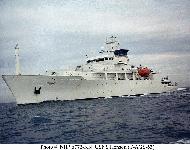

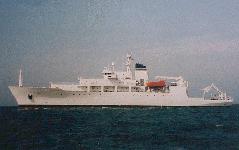


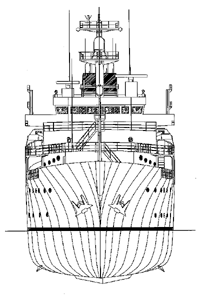
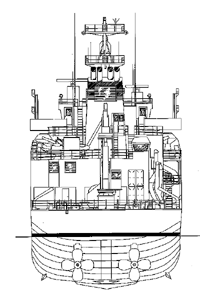 Click on the image to see Ship's sensors in action (373kb animated GIF)
Click on the image to see Ship's sensors in action (373kb animated GIF)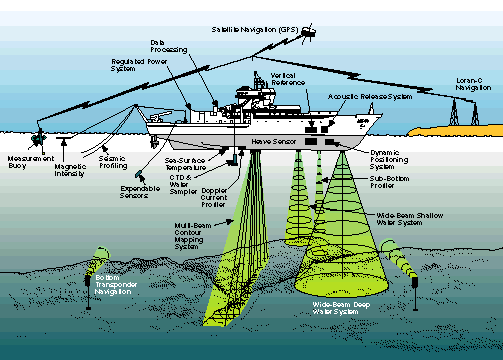




Survey Ships gather data which provides much of the military's information on the ocean environment. Oceanographic and hydrographic survey ships are used to study the world's oceans. The collected data helps to improve technology in undersea warfare and enemy ship detection. The oceanographic and hydrographic survey ships' multibeam, wide-angle precision sonar systems make it possible to continuously chart a broad strip of ocean floor. Military Sealift Command's Special Missions program supports worldwide oceanographic programs with ships which perform acoustical, biological, physical and geophysical surveys.
The T-AGS 60 class ships are designed and constructed to provide multi-purpose oceanographic capabilities in coastal and deep ocean areas including; physical, chemical, and biological oceanography; multi-discipline environmental investigations; ocean engineering and marine acoustics; marine geology and geophysics; and bathymetric, gravimetric, and magnetometric surveying. Typical missions of the T-AGS 60 class ships may include: oceanographic sampling and data collection of surface, midwater, and ocean floor parameters; the launching, recovering, and towing of scientific packages both tethered and autonomous including the handling, monitoring, and servicing of remotely operated vehicles (ROVs); shipboard oceanographic dataprocessing and sample analysis; and precise navigation, trackline maneuvering, and station keeping to support deep ocean and coastal surveys. Besides mapping the ocean floor to update nautical charts, the Navy's oceanographic ships typically conduct sampling of the physical properties of the water column as well as the composition of the ocean floor, launch and recovery of instrument packages, acoustic property measurements, and process and analyze the data on board with the latest computer technology. All the Navy's oceanographic survey ships carry the latest in over-the-side sensors and sampling equipment including bathythermographs, bottom corers, and seismic equipment. After the collapse of the Soviet Union, it quickly became apparent that the likely focus of future naval operations would be the shallow coastal waters of the world rather than the open ocean and the Chief of Naval Operations signed out a new policy for naval oceanography. It emphasized that, in addition to the Cold War-era deep-water missions, naval oceanographers must master the complicated tangle of problems that make up the science of the littoral, or near-shore areas: beach profiles, reefs, bars, shallows, shoals, channels, tides, sediment, turbidity, land cover and terrain, dust, traffic, rain rates, river runoff, sub-bottom characteristics, fine scale hydrography, and biologics, as well as the complex weather patterns inherent in any coastal area. Navy's new focus on littoral operations has created a large backlog of high-priority oceanographic, hydrographic, and geophysical survey requirements. To carry out this expanded mission, Naval oceanographers employ traditional means (ships, boats, planes), and new technologies (satellite, remote sensors, etc.), while also making use of the resources of other national and international agencies. T-AGS 60 class ships are designed with a common bus diesel electric propulsion system consisting of twin screw propellers driven through Z-drives. The Z drives, which have been installed on several new and converted oceanographic ships, include gear reduction and 360 degree thrust direction control in a compact unit. Elimination of conventional reduction gears and long propeller shafts frees up space for oceanographic uses. Complete thrust direction control provides unparalleled ship control and maneuverability to permit precise position keeping and track line following. Continuous variable control of ship speed can be maintained up to maximum speed. The Machine Plant is designed for unattended operation. The integrated electric propulsion and auxiliary machinery systems are controlled and monitored from the Machinery Control Station (MCS) , located on the first platform. The power generating system is configured for maximum flexibility. Two (2) 2435 KW and two (2) 1825 KW diesel generators are integrated to provide power to the propulsion system, ship service, and laboratories through a power conditioner. A portable deck mounted generator can supply ship service power via a main deck connector for quiet ship operations. The 3,500 sq ft working deck affords space for concurrent oceanographic operations. The handling gear in capable of overside operations including the carrying, launching, and recovering of equipment on the starboard side from midship to stern. The T-AGS 60 class ships are equipped with three (3) multi-purpose cranes, one articulated davit, both side and stern U-Frames, and five (5) types of winches to aid in oceanographic missions and experiments. The T-AGS 60 class ships have permanent accommodations for 55 persons. There are fifteen (15) single and twenty (20) double staterooms. Manning levels are typically 52 persons including 25 ship officers and crew members and 27 scientist/technicians. In addition to the three (3) permanent spare accommodations, facilities are provided for portable deck vans offering additional accommodations for five (5) persons. Other amenities include: separate officer�s and crew�s mess, lounge and laundry facilities, and exercise room, hospital, and surveyor�s library and conference area. The detail design and ship construction contract for the first two T-AGS 60 class ships was awarded to Halter Marine, Inc., Moss Point, MS on January 30, 1991. The contract included an option for a third ship which was exercised on May 29, 1992. A separate procurement for a fourth ship was awarded to Halter Marine, Inc., on October 20, 1994. This contract also included options for two additional ships. The fifth T-AGS 60 Class ship, (T-AGS 64) is under construction and will be delivered in June 2000. A sixth new T-AGS 60 class ship was partially funded in the FY98 budget, and when constructed will complete the modernization of the Oceanographer of the Navy's fleet of eight survey ships. However, at launch the Bruce C. Heezen was characterized as "the last of five ships in the Pathfinder class" and the status of the sixth unit is uncertain. The first three T-AGS 60 class ships are named in commemoration of former surveying vessels. The first of its class, the T-AGS 60, is named the United States Naval Ship (USNS) PATHFINDER after PATHFINDER (AGS 1) (1942-1946) which earned two battle stars in WWII in the Pacific theater. T-AGS 61, USNS SUMNER, commemorates SUMNER (AGS 5) which earned three battle stars in WWII, and was named for the late Captain Thomas Hubbard Sumner (1807-1876). The T-AGS 62 is designated the USNS BOWDITCH commemorating the service of the two previous surveying ships (AG 30 and T-AGS 21) that carried the name of the American astronomer and navigator Nathaniel Bowditch (1773-1838). The fourth of the T-AGS 60 class ships, T-AGS 63 is named USNS HENSON in honor of the Afro-American explorer Matthew A. Henson, who accompanied Robert E. Peary when he discovered the North Pole in 1909. A nationwide student contest was held in Fall 1997 to select a name for T-AGS 64. That name, Bruce C. Heezen, was announced in May 1998 by the Secretary of the Navy. Dyn Marine Services of Virginia, Inc.(DMS) a unit of DynCorp, manages, operates, and maintains these ships for the Naval Oceanographic Office (NAVOCEANO) in Mississippi. DMS provides logistics, operations, engineering, and manning support for these US Naval oceanographic ships which are coordinated from the DMS Reston office. The ships are operated worldwide conducting ocean surveys at the direction of NAVOCEANO, with Commander Military Sealift Command (COMSC) acting as the Administrative Command.Specifications | |
| Builder | Halter Marine Moss Point, Miss |
| Power Plant |
Diesel-electric; 4 EMD/Baylor diesel generators; 11,425 horsepower (8.52 MW); 2 GE CDF 1944 motors; 8,000 horsepower (5.96 MW) sustained; 6,000 horsepower (4.48 MW); 2 Lips Z drives; bow thruster, 1,500 horsepower (1.19 MW) |
| Length | 329 feet |
| Beam | 58 feet |
| Draft | 19 feet |
| Displacement |
Displacement at Full Load 5,000 LT Lightship Displacement 3,019 LT |
| Speed | 16 knots |
| Station Keeping | 300 foot radius with 2 Kts current, 27 Kts wind |
| Endurance |
12,000 NM @ 12 Kts Plus 29 days @ 3 Kts with 10% Fuel Reserve |
| Crew |
Total Accommodations 55 Officers and Crew 25 Scientists 27 Spares 3 |
| Aircraft | none |
| Mission Electronics |
Multibeam Echo Sounding System (SIMRAD Inc. EM121A) is a 12 kHz, 121 beam, 1 degreee bathymetric sonar system capable of hydrographic charting in waters from 10 -11,000 meters real time with pitch, roll, heave, and azmimuth correction (see graphic). Deep/ Shallow Water Echo Sounder System (ODEC BATHY-2000) is configured as a 12/33 kHz system which provides single beam data for depths to 12,000 meters for check the accuracy of the multibeam center beam information. Sub-bottom Profiler (ODEC BATHY-2000) is configured as a 3.5 kHz wide beam shallow penetration system which in water depths to 10,000 meters is capable of determining sea bed morphology (external structure of rocks in relation to erosion of topographic features) and sediment profiles to 50 meters, and compensating for ship motion. Seismic System (DWS International Inc.) is a deep penetration sub-bottom profiling system which generates and receives acoustic impulses from a towed sound projector to map geological formations. Applications include marine geology, geophysics, topography, and bathymetry surveys. Acoustic Doppler Current Profiles (RD Instruments VM-0150) is a 150 kHz system which provides profiles of ocean current speed and direction at depths to 380 meters, the backscatter echo level of the returns from those levels, bottom depth, and vessels true ground speed. Expendable Sensor Subsystem (Sippican) launches and monitors various sensors including Expendable BathyThermograph (XBT) and Expendable Sound Velocity Profiles (XSV). Systems support multipurpose oceanography surveys and provides correction to sonar systems for speed pf sound through water columns. Magnetometer (E#G&G G811/813) uses magnetics for mapping of the earth�s magnetic field. Conductivity, Temperature Depth System (Falmouth ICTD) provides full ocean profiles of conductivity and temperature versus depth for depths of up to 7,000 meters and supports most oceanographic surveys. Water Sampler Subsystem (General Oceanic) operates with the CTD to collect water samples in depths to 7,000 meters using a rosette sampler, niskin bottles, and a (Guideline Portasal 8410) salinometer. Bottom Transponder Navigation System (Benthos Inc. DS-7000-16) is a 5 to 50 kHz real time navigation system for positioning the ship with regard to a fixed acoustic Deep Licean Pinger (Datasonic BFP-312) transponder network. Acoustic Release System (EG&G 8011A) provides command and control to activate, interrogate, release, and locate deep ocean pingers. |
Ships | ||||||
| Name | Number | Builder | Homeport | Ordered | Commissioned | Decommissioned |
| Pathfinder | T-AGS-60 | Halter | Atlantic | 30 Jan 1991 | 28 Oct 1994 | |
| Sumner | T-AGS-61 | Halter | Pacific | 30 Jan 1991 | 30 May 1995 | |
| Bowditch | T-AGS-62 | Halter | Atlantic | 25 May 1992 | 19 Jul 1996 | |
| Henson | T-AGS-63 | Halter | Atlantic | 20 Oct 1994 | 20 Feb 1998 | |
| Bruce C. Heezen | T-AGS-64 | Halter | 13 Jan 1997 | 25 Mar 1999 | ||
| T-AGS-65 | Halter | building | 21 Dec 1998 | Dec 2001 | ||








 Click on the image to see Ship's sensors in action (373kb animated GIF)
Click on the image to see Ship's sensors in action (373kb animated GIF)